Research matlab program on shared energy storage mechanism based on combined two-way auction
Reference: "Research on shared energy storage mechanism based on combined two-way auction"
Abstract: In order to meet the complementary and alternative needs of energy storage users in shared energy storage, and to solve the monopolistic competition problem that may exist in conventional one-way auctions, a shared energy storage mechanism based on combined two-way auctions is proposed. In this mechanism, energy storage operators and energy storage users conduct combined two-way auctions under the organization of auctioneers. The auction consists of four stages: bidding, winning bid decision problem, resource matching and pricing, and fund settlement. Compared with the existing auction mechanism, this mechanism supports "AND" bidding, so that buyers' complementary needs can be accurately and concisely expressed. In the aspect of determining the winning bid, a mixed integer nonlinear programming model with the goal of maximizing social welfare is established. Further, the model is equivalently transformed into a mixed integer linear programming model, which greatly reduces the computational time complexity. In terms of pricing, a pricing mechanism that distributes social benefits equally between buyers and sellers is proposed, which breaks the monopoly disadvantages of traditional one-way auctions. Finally, an example is used to verify the effectiveness of the proposed mechanism. Key words: shared energy storage; combined two-way auction; complementarity; alternative energy storage is one of the key technologies to promote the efficient use of renewable energy and support the construction of energy Internet. With the rapid development of renewable energy power generation, the application of energy storage on the power generation side and user side continues to grow [4]. At present, energy storage is still facing the development bottleneck of high cost and immature business model, and shared thinking may help energy storage break through this bottleneck. Shared energy storage refers to the concept of using the complementarity of energy storage needs of different energy storage users to improve the utilization rate of energy storage equipment and create value. The shared objects include energy storage power and energy storage capacity. Generally speaking, the pricing mechanism of shared energy storage can be roughly divided into four categories: 1) Fixed price, that is, the price has nothing to do with time, supply and demand, etc. Literature [8] proposes that cloud energy storage services can be priced by capacity, by traffic and by package. Fixed prices can stabilize users' expectations on prices, but they cannot reflect users' evaluations of energy storage utility. 2) Peak and valley electricity prices, that is, the price is related to time or supply and demand. The pricing strategy of shared energy storage in literature [9] is to take the electricity price at the off-peak time when the supply of energy storage exceeds the demand, and to take the electricity price at the peak time when the supply of energy storage exceeds the demand. 3) Benefit or cost sharing. At this time, the energy storage price actually faced by energy storage users depends on the allocation strategy of benefits or costs. Literature [10] established a community comprehensive energy system model including shared energy storage and proposed a corresponding user collaborative optimization strategy, that is, first minimize the overall energy cost and then allocate the cost according to the energy consumption. Literature [11] established a distributed prosumer-shared energy storage model based on cooperative games, and according to Shapely value distribution shares energy storage benefits. 4) Auction, that is, energy storage users or energy storage sellers bid, and one of them or the auctioneer decides the winning bidder and the transaction price. Literature [12] established a non-cooperative master-slave game model based on Vickery auction between household users with energy storage and shared energy storage controllers, in which the price of shared energy storage is determined by the result of Vickery auction. However, none of the above shared energy storage mechanisms can reflect the complementary and alternative needs of energy storage users for energy storage. In combination auctions, buyers can bid for items they are interested in, which can effectively solve this problem and reduce the number of transactions and transaction costs. See literature [14] for the explanation of complementarity and substitution. Literature [15] regards energy storage in different periods as different items, and establishes a community-level shared energy storage mechanism based on combined one-way auctions. However, this mechanism does not support "AND" bidding, which prevents energy storage users from expressing their complementary needs in the bidding. On the other hand, energy storage sellers must bid at the same price for each time period, which makes it impossible for sellers to fully express their price requirements for different time periods. In addition, combined one-way auctions still belong to the "one-to-many" market structure, and a single seller has a monopoly advantage. In order to overcome the monopoly advantage problem in combinatorial one-way auctions, researchers proposed the idea of combinatorial two-way auctions. Combined two-way auction is a combination of combination auction and two-way auction, with a "many-to-many" market structure. Literature [18] established a mechanism for power trading between microgrids based on combined two-way auctions, but this mechanism also does not support "AND" bidding, which prevents buyers from expressing their complementary needs, thus greatly reducing the significance of combined auctions. The result of the Vickery auction is confirmed. However, none of the above shared energy storage mechanisms can reflect the complementary and alternative needs of energy storage users for energy storage. In combination auctions, buyers can bid for items they are interested in, which can effectively solve this problem and reduce the number of transactions and transaction costs. See literature [14] for the explanation of complementarity and substitution. Literature [15] regards energy storage in different periods as different items, and establishes a community-level shared energy storage mechanism based on combined one-way auctions. However, this mechanism does not support "AND" bidding, which prevents energy storage users from expressing their complementary needs in the bidding. On the other hand, energy storage sellers must bid at the same price for each time period, which makes it impossible for sellers to fully express their price requirements for different time periods. In addition, combined one-way auctions still belong to the "one-to-many" market structure, and a single seller has a monopoly advantage. In order to overcome the monopoly advantage problem in combinatorial one-way auctions, researchers proposed the idea of combinatorial two-way auctions. Combined two-way auction is a combination of combination auction and two-way auction, with a "many-to-many" market structure. Literature [18] established a mechanism for power trading between microgrids based on combined two-way auctions, but this mechanism also does not support "AND" bidding, which prevents buyers from expressing their complementary needs, thus greatly reducing the significance of combined auctions. The result of the Vickery auction is confirmed. However, none of the above shared energy storage mechanisms can reflect the complementary and alternative needs of energy storage users for energy storage. In combination auctions, buyers can bid for items they are interested in, which can effectively solve this problem and reduce the number of transactions and transaction costs. See literature [14] for the explanation of complementarity and substitution. Literature [15] regards energy storage in different periods as different items, and establishes a community-level shared energy storage mechanism based on combined one-way auctions. However, this mechanism does not support "AND" bidding, which prevents energy storage users from expressing their complementary needs in the bidding. On the other hand, energy storage sellers must bid at the same price for each time period, which makes it impossible for sellers to fully express their price requirements for different time periods. In addition, combined one-way auctions still belong to the "one-to-many" market structure, and a single seller has a monopoly advantage. In order to overcome the monopoly advantage problem in combinatorial one-way auctions, researchers proposed the idea of combinatorial two-way auctions. Combined two-way auction is a combination of combination auction and two-way auction, with a "many-to-many" market structure. Literature [18] established a mechanism for power trading between microgrids based on combined two-way auctions, but this mechanism also does not support "AND" bidding, which prevents buyers from expressing their complementary needs, thus greatly reducing the significance of combined auctions.
1 Modeling of shared energy storage problem based on combined two-way auction
Figure 1 shows the model architecture of shared energy storage system studied in this paper. Under the organization of auctioneers, energy storage sellers and energy storage buyers conduct combined auctions of energy storage electricity in various periods. The stored energy in different periods is regarded as different items. There are M time periods in a day for the auction of energy storage electricity, and the rest of the time periods are for charging the energy storage device.
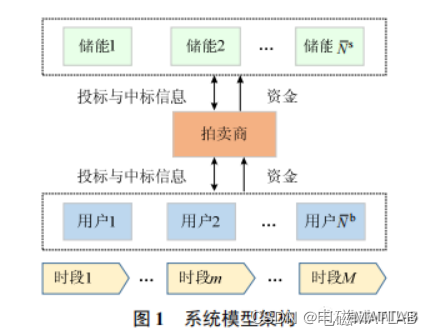
1.1 Participants
1.1.1 Energy storage buyers
Energy storage buyers purchase energy storage services to reduce their own energy costs. Energy storage buyers need to report to the auctioneer their willingness to purchase energy storage at each time period and the corresponding bidding prices.
1.1.2 Energy storage sellers
Energy storage sellers provide energy storage services and need to report to the auctioneer their willingness to supply energy storage at each time period and the corresponding bidding prices. Energy storage sellers may be independent energy storage operators, or users who have installed energy storage. Therefore, the roles of energy storage sellers and buyers are not fixed, and the sellers in this auction may also become energy storage buyers in the next auction.
1.1.3 Auctioneer
The auctioneer is responsible for organizing the entire auction process between energy storage sellers and energy storage buyers, mainly including the collection of bidding information, determination of the winning bidder, resource matching and pricing, and fund settlement.
1.2 The auction process
starts with the auctioneer issuing a bidding start signal, and each energy storage buyer and seller submits the bidding information to the auctioneer in a sealed manner, and then the auctioneer issues a bidding end signal, and the bidding process ends; then the auctioneer, based on the bidding information of each participant, Determine the winning bidder with the goal of maximizing social welfare, and match the winning energy storage resources at each time period to determine the corresponding transaction price, and then calculate the total expenditure of each buyer and the total income of each seller; finally, the auctioneer will , resource matching results, pricing results, participants’ income and expenditure and other information; the auction results are reported to the The microgrid control center or the distribution network dispatch center, and then the microgrid control center issues control instructions or the distribution network dispatch center issues dispatch instructions to execute the auction results. After the auction result is executed, the buyer transfers the payable to the auctioneer, and then the auctioneer transfers the receivable to the seller, and the auction process ends.
2 Bidding and Winning Bid Decision Mechanism
2.1 Bidding
2.1.1 Seller Bidding Information

2.1.2 Buyer Bidding Information

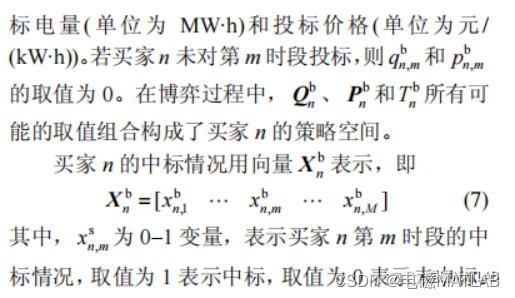
2.2 Winning bid determination problem
2.2.1 Objective function
After the buyer and seller bid, the auctioneer needs to determine the winning bidder. In the combined two-way auction, the "many-to-many" market structure breaks the monopoly advantage of one party in the one-way auction. In one-way auctions, the winner is often determined with the goal of maximizing the welfare of the monopoly party, but here the auctioneer determines the winner with the goal of maximizing social welfare. The social welfare Wso is the sum of the seller's surplus and the buyer's surplus, which is also equal to the difference between the buyer's bid price and the seller's asking price:
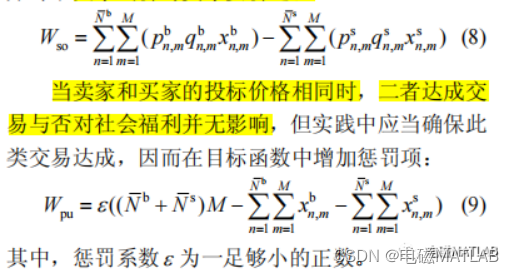
2.2.2 Constraints
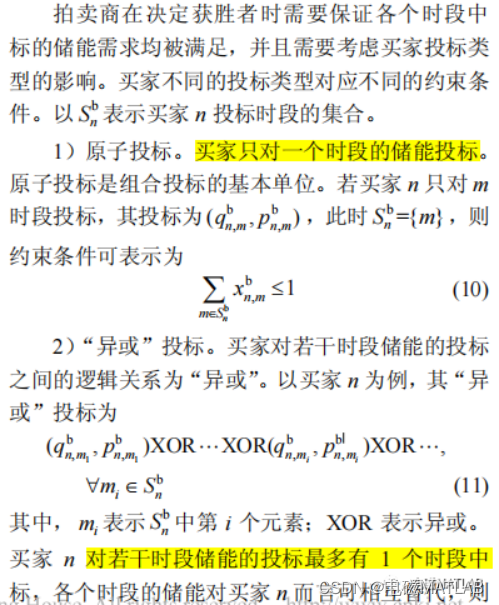
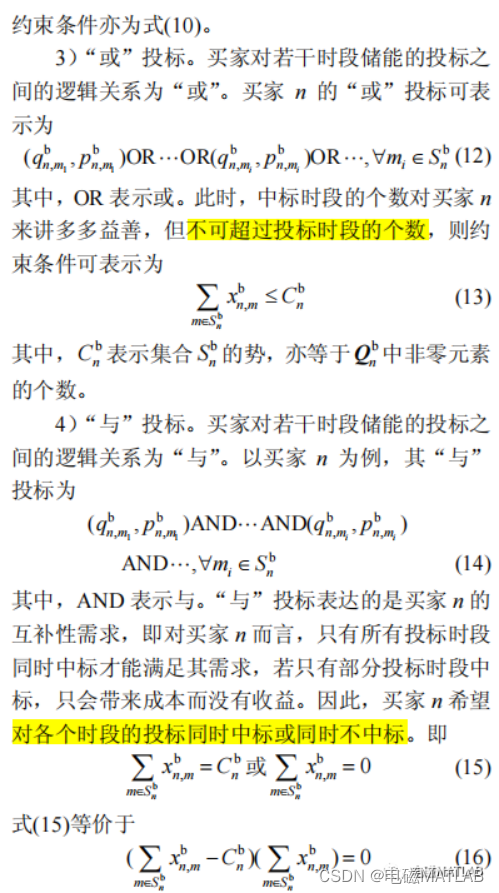
3 Calculation example analysis
Assume that there are 6 periods of energy storage in a day that can be auctioned, and energy storage in different periods is regarded as different items. The calculation example contains 7 energy storage buyers and 6 energy storage sellers. The value of penalty coefficient is 1×106. In this scenario, the bidding strategy of each energy storage buyer and energy storage seller is fixed and does not consider the transmission and distribution price. The bidding data of energy storage buyers is shown in Table 1, where (10,1.2) means that the buyer's bidding power for energy storage during this period is 10 MW·h, and the bidding price is 1.2 yuan/(kW·h). Buyer 1 and Buyer 4 made "AND" bids for energy storage in multiple time periods, expressing their complementary energy storage needs. Buyer 2 and Buyer 6 make "XOR" bids for energy storage in multiple time periods, expressing their demand for alternative energy storage. Buyer 3 and Buyer 5 are buyers who want as much as possible, and their bids are "or" bids. Buyer 7 placed an atomic bid only for energy storage in period 6.
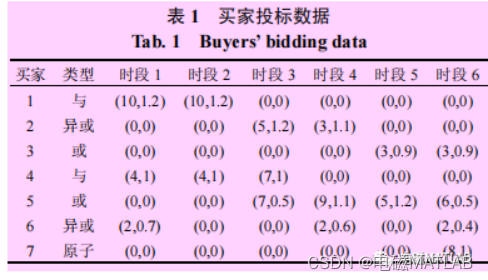
The seller's bidding data is shown in Table 2, where (5, 0.9) means that the energy storage seller's bidding power for the energy storage period is 5 MW·h, and the bidding price is 0.9 yuan/(kW·h). Energy storage sellers can bid for several time periods, and the bidding power and bidding price in each time period do not have to be the same, so that each seller can fully express its price requirements for energy storage in different time periods.

4 Calculation results Program running results
1) The buyer wins the bid
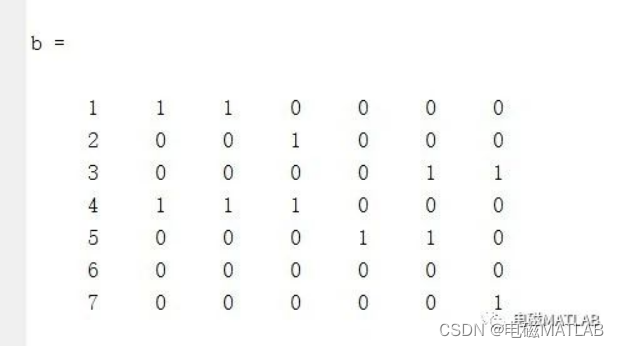
2) The results of the seller's bid winning program
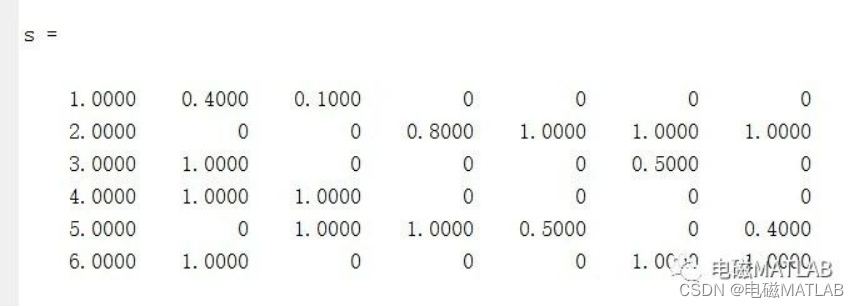
Literature results
1) The buyer wins the bid
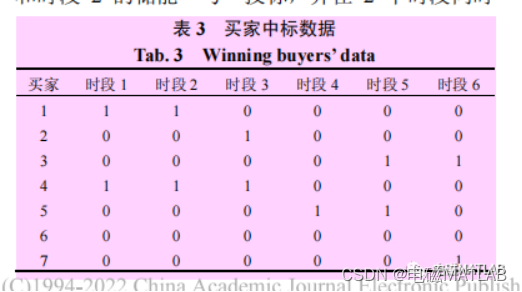
2) The seller wins the bid
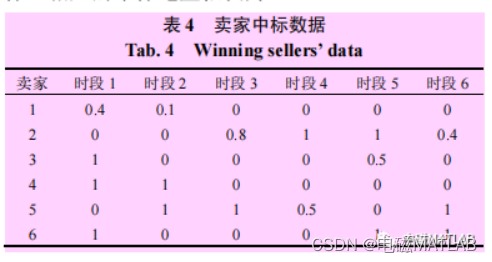
4 matlab program
clc
clear
close all
%% Buyer information
%0, atom; Buyer only bids for energy storage in one period
% 1 or; cannot exceed the number of bidding periods
% 2 and; bids for all periods of bidding at the same time or Not winning the bid at the same
time % 3 XOR; bids for energy storage in several time periods have at most 1 time period
%type+capacity
S_b1=[
2, 10, 10, 0, 0, 0, 0;
3, 0, 0, 5, 3 , 0, 0;
1, 0, 0, 0, 0, 3, 3;
2, 4, 4, 7, 0, 0, 0;
1, 0, 0, 7, 9, 5, 6;
3, 2 , 0, 0, 2, 0, 2;
0, 0, 0, 0, 0, 0, 8;
];
% serial number + price
S_b2=[
1, 1.2, 1.2, 0, 0, 0, 0;
2, 0, 0, 1.2, 1.1, 0, 0;
3, 0, 0, 0, 0, 0.9, 0.9;
4, 1, 1, 1, 0, 0, 0;
5, 0, 0, 0.5, 1.1, 1.2, 0.5;
6, 0.7, 0, 0, 0.6, 0, 0.4;
7, 0, 0, 0, 0, 0, 1;
];
%%Seller information
%serial number+capacity
S_s1=[
1, 5, 10, 10, 0, 0, 0;
2, 0, 0, 5, 5, 2, 5;
3, 2, 0, 0, 0, 4 , 3;
4, 5, 5, 0, 0, 0, 0;
5, 0, 8, 8, 8, 0, 5;
6, 5, 0, 0, 8, 4, 4;
];
%Number+ Price
S_s2=[
1, 0.9, 0.9, 0.9, 0, 0, 0;
2, 0, 0, 0.8, 0.7, 0.5, 0.5;
3, 0.4, 0, 0, 0, 0.6, 0.7;
4, 0.6, 0.6, 0, 0, 0, 0;
5, 0, 0.7, 0.7, 0.7, 0, 0.5;
6, 0.5, 0, 0, 1, 0.4, 0.4;
];
. . . . . . . slightly